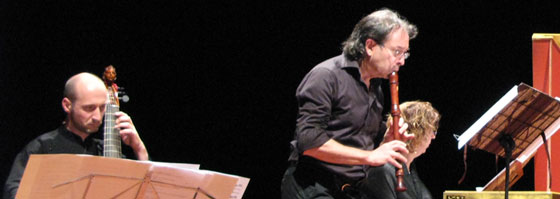| Charivari Ensemble |
Armonia delle Sfere |
The bank of turf |

|
 |
 |
|
Charivari Ensemble,
composed of a small group of musicians, is specialised in performing
medieval, renaissance and baroque music.
|
Armonia delle sfere
is a musical group formed in Bologna, at the Conservatory of music,
specialized in the repertory of seventeenth and eighteenth centuries.
|
Irish and Scottish Folk Music. |
| Programmi per Concerti |
| Charivari Ensemble |
|
| Il riposo dell'amore |
| “IL RIPOSO DELL’AMORE” La “cortezia” between Languedoc and Limousin1
is a concert-performance based on texts and lyrical poetries from
ancient Occitan literature, with an actress: Sara Galli, on stage. The
group uses medieval instruments such as fiddle, lute, recorders,
bagpipes, symphonia, lyra etc. In program: compositions by troubadours,
trouvères and trobairitz from various sources, Estampies and Danses royales. Charivari Ensemble Daniele Salvatore: recorders, pipe and tabor, zitera, saz, tambourine, voice Graziella Guardiani: soprano, recorders, percussions Marco Giacintucci: viella, lyra, symphonia, pipes Sara Galli: spoken voice IL RIPOSO DELL’AMORE La “cortezia” between Languedoc and Limousin Poetry and music by troubadours, trouvères and trobairitz (various sources) Estampies & Danses royales from Ms BN. Fr 844 (end of XIII century) Anonimo (XII cent. – XIII cent.): A l’entrada del tens clar (balada) Arnaut Daniel (end of XII century): Lo ferm voler qu’el cor m’intra (sestina) Anonimo (end of XIII century): Danse Guiraut de Bornelh (c. 1140 – c. 1200): Reis glorios (alba) Anonimo: La Sexte Estampie Royal Bernart de Ventadorn (cent. XII): Can vei la lauzeta mover (canso) Anonimo: Danse real Gillebert de Berneville (XIII cent.): Cuidoient li losangier (rotroencha) Guillaume D’Amiens (2th mid- thirteenth century): Prendés i garde (rondeau) Anonimo: La Quarte Estampie Royal Adam de la Halle (c. 1230 – c. 1288): Tant con je vivrai (rondeau) Anonimo: La Quinte Estampie Réal Raïmbaut de Vaqueiras (2th mid- twelfth century – 1207): Kalenda maya (estampida) ------------------------------------ 1The Rest of Love. The ‘cortezia’ (courtly love) between Languedoc and Limousin. |
| O i miei amanti |
| “O MIEI AMANTI”2 Villani e villanelle: l’amor scortese is a program where the woman, nearly always of the people, is protagonist. The program based on villanelle, villotte and canzoni alla napolitana from original editions of sixteenth century kept at the Bibliotheca of Conservatory of Bologna. CHARIVARI ENSEMBLE: Silvia Testoni: sopran Emanuela Di Cretico: recorder, cromhorn Daniele Salvatore: recorder, cromhorn, percussions, pipe and tabor Dante Bernardi: dulcian, cromhorn, bombarde, fiscaletto Elena Dalla Casa: harpsichord Stefano Rocco: renaissance lute and guitar Anonimo Ciaccona Anonimo from “Apografo Miscellaneo Marciano” (XVI cent.) Cossi esstrema è la doglia Gian Domenico Del Giovane (Nola, c. 1510 - Napoli 1592) from “ Canzoni Villanesche a 3 voci ”, Venezia, 1545 Fontana che dai acqua from “Canzoni Napolitane a tre voci, Libro Secondo”, Venezia, 1566 Si ben voltasse Diego Ortiz (Toledo, c. 1525 - ?, after 1570) from “Trattado de Glosas sobre Clausulas”, Roma, 1553 Recercada primera Recercada segunda D’incerto (XVI cent.) from “Corona - Primo Libro delle Napolitane a tre et a quattro voci”, Venezia, 1572 Bon cacciator già mai from “Canzon Napolitane a tre voci”, Venezia, 1566 Villanella villanella Baldassarre Donato (c. 1530 – Venezia, 1603) from “Il Primo Libro di Canzon Villanesche alla Napolitana a tre voci”, Venezia, 1550 Chi la gagliarda Anonimo Passamezzo antico Anonimo Passamezzo moderno Tiberio Fabrianese (XVI cent.) from “Il Primo Libro di Canzon Villanesche alla Napolitana a tre voci”, Venezia, 1550 La canzon della gallina Girolamo Conversi (Correggio, cent. XVI) from “Il Primo libro delle canzoni a cinque voci”, Venezia, 1573 Sola soletta Domenico Maria Ferrabosco (Bologna, 1513 – 1574) from “Primo libro di madrigali de diversi eccellentissimi autori a misura di breve a quattro voci”, Venezia, 1542 Io mi son giovinetta Io mi son giovinetta, intavolatura strumentale di Bernhard Schmid il vecchio (Strasburgo, 1535 – 1592) from “Zwey Bücher einer neuen kunstlichen Tabulatur auff Orgel und Instrumenten”, Strasburgo, 1577 Leonardo Primavera (Barletta, c. 1540 – Napoli?, after 1585) from “Il Primo Libro de Canzoni Napolitane a tre voci”, Venezia, 1570 Dormendo mi sonniava Mamma nu grosso pollice Tre donne belle fanno gran battaglia Girolamo del Montesardo (cent. XVI-XVII) from “Nuove Inventione d’Intavolatura”, Firenze, 1606 Folia chiamata così da spagnuoli Antonio Scandello (Bergamo, 1517 - Dresda, 1580) from “El Primo Libro de le canzoni napoletane”, Norimberga, 1564 Haveva na ga. from “Il II Libro delle Canzoni Napolitane”, Monaco, 1577 S’io canto e tu mi spacci per cicala ----------------------------------- 2 Oh, my lovers! Top |
| Celesti giri e musicali accenti |
| “CELESTI GIRI E MUSICALI ACCENTI”3 Music and dances between Middle Ages and Renaissance is a program about music and dance drawn from important medieval and renaissance manuscripts. The show doesn't follow a chronological order: we preferred to follow a development for themes; the public has the assignment to gather the suggestions and to find the thread along which footsteps, voices and notes are flowing. About the dance, it is important to know that, in west Europe, in the XV century dance came for the first time encoded in two fundamental treatises: De arte saltandi & choreas discendi 4 (1416) by Domenico da Piacenza and De pratica seu arte tripudii5, known in various following editions with content not perfectly the same and written mainly in the years 1460 – 1475, by Guglielmo Ebreo da Pesaro. The social and commemorative role of the art of Terpsichore grew in Italian courts of the sixteenth century, when knowing the dance was a fundamental requirement in the life of the courtier. Two Italian ‘maestri di ballare’6 who left important documents are Fabrizio Caroso (Sermoneta (?), Latina, between 1527 and 1535 - ?, after 1605) with Il Ballarino7 (Venice, 1581) and his reediting entitled Nobiltà di dame8 (Venice 1605) and Cesare Negri (Milan, about 1535 - ibid, after 1604) with the treatise Le gratie d’Amore9 (Milan, 1602): from each of these collections of the XV and XVI century, you will see the reconstruction of some choreographies. Variations and adaptations will be instead performed on other music for dance: an important author present in the program is Thoinot Arbeau (Digione, 1520 – Langres, 1595); in our show we propose a few variations taxen from his choreographies in Orchésographie (1589), one of the most detailed dancing treatises used in France during the XVI century. Then you will see some variations of gaillard on Tourdion, from Pierre Attaignant’s editions (Douai (?), about 1494 – Paris, 1530) and on Gaillarde by Michael Praetorius (Creuzburg, 1571 – Wolfenbüttel, 1621). This last one is drawn from the Terpsichore Musarum, (Wolfenbüttel, 1612), one of the amplest collections of music for dance: about 300 music pieces of French origin, handed down from the dance teacher of the Friedrich Duke. The sounds that open the show arrive to us from one of most important collections of medieval music: Cantigas de Santa Maria. The words of a troubadour of the XIII century, Gillebert of Berneville, accompanies the melody of Cuidoient le losangier10 instead. Then we can find the “allegrezza”11 in the anonymous saltarello of the end of the XIV century and in the known songs from the medieval Carmina Burana (XII century), hymns to pleasure and fun with a touch of satire toward powerful person habits. A famous sentence says: “chi vuol esser lieto sia del doman non c’è certezza”12 there is the topic of Hoy comamos y bebamos: a Spanish song from the collection Cancionero musical de Palacio, the most important chansonnier, above all for the treasures of surviving material, and also known with the name of Cancionero de Barbieri, from the name of his discoverer. There are, in this cancionero, loving typical villancicos 13 of the musicians and singers of the Castilian court of Regina Isabella or of Aragonese court of King Ferdinando. Rodrigo Martines comes from the same anthology: he is the symbol of a man we can define “the village idiot”. Propina de melior always comes from Spanish area; there is in the Cancionero musical de Sevilla, also known as Colombino Codex, from the name of the library of Seville where the codex is kept. Two pieces from Italian area have drawn from Il primo libro de balli 14 (Venice, 1578) by Giorgio Mainerio (Parma, about 1535 – Aquileia, 1582), one of the most important Italian sources for the repertoire of dance music, that before was known and transmitted verbally, even if practised. Claudio Monteverdi (Cremona, 1567 – Venezia, 1643) closes the performance with a yearning passacaglia from the 8th book, dedicated to love and war, one of his most important published sequence of madrigals. (Silvia Pezzenati, Daniele Salvatore)
-------------------------------------3 Celestial Dances and Musical Accents. 4 On the Art of Dancing and Choreography. 5 On the Practice or Art of Dancing. 6 Dance Teachers. 7 The Dancer. 8 Nobility of Ladies. 9 Graces of Love. 10 The Backbiters tell. 11 Joyfulness. 12 Enjoy yourself because our future is uncertain. (Lorenzo de’ Medici). 13 Typical polyphonic Spanish song. 14 The First Book of Dance. CHARIVARI ENSEMBLE: Emanuela Di Cretico: recorders, cromhorn Daniele Salvatore: zither, recorders, cromhorn, pipe and tabor, renaissance guitar, voice Dante Bernardi: dulcian, bagpipe, bombarde, cromhorn Laura Pezzenati: tambourine, castanets, dance Silvia Pezzenati: dance "La musica porge a tutti i nostri sensi singular conforto, quasi come ella fusse di nostri spirti naturalissimo cibo..." (dal De pratica seu arte tripudii di Guglielmo Ebreo) Quen a omagen da virgen/Como poden, from Cantigas de Santa Maria ANONIMO (XIII century) Amoroso, from De pratica seu arte tripudii GUGLIELMO EBREO DA PESARO (c. 1420 - ?, after 1480) La fia Guielmina, from De arte saltandi et choreas discendi DOMENICO DA PIACENZA (Piacenza, at the end of cent. XIV - ? Ferrara c. 1470) Gioliva, from De pratica seu arte tripudii GUGLIELMO EBREO DA PESARO Cuidoient li losangier, Paris, Arsenal MS 5198 GUILLEBERT DE BERNEVILLE (XIII cent.) So ben mi c’ha bon tempo, from Le gratie d’amore CESARE NEGRI (1535c. - after 1604) Ardente Sole, from Il ballarino MARCO FABRITIO CAROSO on Pass et medio, from Danserye TIELMAN SUSATO (c. 1515 – c. 1566) Alta Mendozza, from Le gratie d’amore by CESARE NEGRI on A lieta vita, GIACOMO GASTOLDI (c. 1555-1609) Schiarazula Marazula, from Il primo libro de balli GIORGIO MAINERIO (c. 1535 - 1582) Propina de melior, from Chanconnier de la Colombina ANONIMO (2th mid-fifteenth century) Bache bene venies – In taberna quando sumus Carmina Burana, BENEDIKTBEUERN (XII cent.), Petit riense from De pratica seu arte tripudii GUGLIELMO EBREO DA PESARO Saltarello III, London, B. M. add 29987 ANONIMO (at the end of XIV cent.) Ungaresca e saltarello from Il primo libro de balli GIORGIO MAINERIO Rodrigo Martines from Cancionero musical de Palacio ANONIMO (Madrid, c. 1490) Spagnoletto, from a choreography by M. F. Caroso su Spagnoletto, from Terpsichore Musarum MICHAEL PRAETORIUS (1571 - 1621) Hoy comamos y bebamos, from Cancionero musical de Palacio JUAN DEL ENCINA (1468 – c. 1530) Tourdion PIERRE ATTAIGNANT (1484 c. - 1552) gagliarda-variations on Gaillarde, from Terpsichore Musarum MICHAEL PRAETORIUS (1571 - 1621) Les Bouffons (variations on choreography di T. Arbeau), from Orchesographie THOINOT ARBEAU (1520 - 1595) Pavana “La Battaglia”, from Danserye TIELMAN SUSATO Amor (Lamento della Ninfa), from Madrigali Guerrieri et Amorosi Claudio Monteverdi (1567 -1643) Top |
| Un caffè con Picander |
|
J. S. Bach, the music and texts by Christian Friedrich Henrici (Picander). The program is based on arias from Bach’s Cantatas and texts by Picander. The program comprises a few instrumental works (Sonata in B minor BWV 1030 and two little pieces by Picander himself: Loure and Suite). The idea of the program derives from Coffee Cantata (BWV 211)
Armonia delle sfere Miho Kamiya - soprano Daniele Salvatore - flute Perikli Pite - viola da gamba Stefano Rocco - theorbo Silvia Rambaldi - harpsichord UN CAFFÈ CON PICANDER J. S. Bach, the music and texts by Christian Friedrich Henrici (Picander) J. S. Bach from Cantata BWV 156 "Ich steh mit einem Fuß im Grabe" - Sinfonia from Cantata BWV 249 "Oratorium Festo Paschali" - Adagio - Seele, deine Spezereien from Cantata BWV 211 "Schweigt stille, plaudert nicht (Kaffeekantate)" - Ei! wie schmeckt der Coffee süße Ch. Fr. Henrici from "Gedichte-Nouvellen" I volume Loure-Suite from Cantata BWV 248 "Und es waren Hirten in derselben Gegend - Weihnachts-Oratorium II" - Frohe Hirten, eilt, ach eilet J. S. Bach -Sonata in B minor BWV 1030 J. S. Bach from "Matthäus-Passion" BWV 244 - Aus Liebe - Erbarme dich Top |
| Il Mondo va in giro |
|
Un viaggio musicale lungo la via Emilia nell’Italia del Seicento (“The world goes round” - A musical tour along the Emilia Way, in the seventeenth-century Italy) This program offers an example with regard to what a voyager of Seicento could have listened traveling “along the Emilia Way”, with some necessary diversions. The Emila Way crosses the Emilia-Romagna region and reachs (or it is very close) towns, where important composers were born, lived or published (Frescobaldi opens the century and Corelli closes it). And in several towns we can find again important manuscripts by others composers. Armonia delle sfere Santina Tomasello - soprano Daniele Salvatore - recordes Mauro Valli - cello Silvia Rambaldi - harpsichord Girolamo Frescobaldi (Ferrara, 1583 - Roma, 1643) from “Il primo libro delle canzoni … per sonare con ogni sorte di stromenti “ (Roma, 1628) - Canzona detta La Bernardinia from “Primo Libro d'Arie Musicali” (Firenze, 1630) - Cosi mi disprezzate - Se l'aura spira Marco Uccellini (Forlimpopoli, 1603 ca. –, 1680) from “Sinfonie boscareccie” (Anversa, 1669) - Symphonia 34 “A gran battaglia” Emilio de’ Cavalieri (Roma, 1550 – 1602) from “La pellegrina” (Firenze, 1589) - O che nuovo miracolo Anonimo (XVII sec.) from “Ms Ravenna ca. 1640” - Aria di Fiorenza Angelo Berardi (Sant’Agata Feltria, c. 1636 - Roma, 1694) from “Sinfonie a violino solo” (Bologna, 1670) - Canzone Seconda. ‘Il Mondo va in giro’ Bernardo Pasquini (Massa e Cozzile, 1637 - Roma, 1710) from “Ms V.273” (Bologna, XVIII sec.) - Pungentissimi sospetti - Non più lagrime - Tenta esercito d’affanni Giuseppe Torelli (Verona, 1658 – Bologna, 1709) from “Concertino per camera, 12 Sonate per violino e violoncello, op.4”, (Bologna, s. d.): - Sonata XII (Introdutione-Adagio, Aria-Allegro, Aria di Giga) Giovanni Battista Bassani (Padova, ca. 1647 - Bergamo 1716) from “Cantate, et arie amorose” (Bologna, 1703) - Più viver così - Ama, e taci Arcangelo Corelli (Fusignano, 1653 – Roma, 1713) from “Six Solos for a Flute and a Bass… Second Part of his Fifth Opera” (Londra, 1702) - Sonata XII “La follia” Antonio Maria Bononcini (Modena, 1677 - 1726) from a Neapolitan manuscript of eighteenth century - Idol mio bel tesoro (cantata per soprano, flauto e basso continuo) (Amoroso - Recitativo - Spiritoso) Top |
| Folìas |
|
Musical folias and obstinate ideas. This
program proposes a survey of some Salvatore’s compositions, wrote for
ancient instruments, and some similar (in the form or inspiration)
musical pieces from XVII and XVIII centuries. Trait-d’union is the
”ground” and basic topic is the ground known like “follia”.
Armonia delle sfere Daniele Salvatore - recorder Perikli Pite - cello Silvia Rambaldi - harpsichord FOLìAS Musical folias and obstinate ideas Michel Farinel (1649 – inizio sec. XVIII) Faronels ground from “The Division Flute”, London 1706 Daniele Salvatore Prima di Boob (1997, for solo harpsichord) Girolamo del Montesardo (sec. XVI-XVII) Folia chiamata così da spagnuoli from “Nuova Inventione d’Intavolatura”, Firenze 1606 Daniele Salvatore Passacaglia della carne e dello spirito (1993) Bernardo Pasquini (1637 – 1710) Passacagli per Petronilla from Berlin manuscript, 1702 Daniele Salvatore Alla fine dell’infinito (2009) Anonimo Ciaccona Daniele Salvatore La Follia (2001) Top |
| Obbligato |
| Flute/viola da gamba and harpsichord sonatas by J. S. Bach. This
program is based on Bach’s sonatas for an instrument (flute or viola da
gamba) and obligato harpsichord. With a perfect definition, B. Kuijken
wrote: «a sonata with obligato harpsichord is really a trio sonata in
which the harpsichordist takes two voices for himself, with the right
hand as one of the melody instruments and the left hand as the basso
continuo». In this program we revise a few virtual trio sonatas playing
some of them with three instruments, like really trio sonatas. In
particular: viola da gamba plays the bass in two flute sonatas, while
flute plays the right hand of harpsichord part in the Sonata in G major BWV 1027 (for viola da gamba and harpsichord) which in a previous manuscript is written for two flutes and continuo (BWV 1039). Armonia delle sfere Daniele Salvatore - flute Perikli Pite - cello Silvia Rambaldi - harpsichord OBBLIGATO! Flute/viola da gamba and harpsichord sonatas by J. S. Bach. Sonata in A major BWV 1032 Largo e dolce – Allegro Sonata in D major BWV 1028 Adagio - Allegro - Andante - Allegro Sonata in G major BWV 1027 Adagio - Allegro ma non tanto - Andante - Allegro moderato Sonata in G minor BWV 1029 Vivace - Adagio - Allegro Sonata in B minor BWV 1030 Andante - Largo e dolce - Presto - [Allegro] Top |
| Charivari Ensemble |
 |
| Charivari Ensemble,
composed of a small group of musicians, is specialised in performing
medieval, renaissance and baroque music. Several other musicians, also
dedicated to ancient music, frequently join the group enabling them to
perform a variety of programs with formations that range from trio to
chamber orchestra. The group, in its various formations, has won prizes in several international competitions and has performed for important associations (Unione Musicale - Torino, Associazione Musicale - Pesaro, Vittorio Cocito - Novara, Giuseppe Tartini - Roma, Amici della Musica – Ragusa, Ass. Liviabella – Macerata, Ass. Cult. L’Orfeo – Spoleto), festivals (Bologna Festival, Restate – Reggio Emilia, Alia Musica – Parma, Festival Cusiano - Lago d’Orta, Echi lontani – Cagliari, Sagra Malatestiana - Rimini, Musica Cortese - Friuli) and historical places of great interest (Castello Sforzesco - Milano, Oratorio Caravita - Roma, Abbazia di Serramonacesca, Museo Medievale - Bologna, Villa Litta – Milano, Villa Spinosa – Negrar/Verona, etc). The group has performed abroad, playing in Egypt (Cairo and Alessandria), Belgium (Bruxelles-Genval) and in Ireland (Dublin and Carlow), recording for Egyptian radio and RTE (Irish radiotelevision). Under the name ‘Aulòs Consort’, the group recorded its first compact-disc with '‘Tactus’ of Bologna (Italy), performing, for the first time, the complete Partitura del primo libro de canzoni francese a 4 & alcune Suonate by Nicolò Corradini. Contemporaneously, the first modern printing of this work was published by ‘Ut Orpheus’ of Bologna under the direction of Daniele Salvatore and Giovanni Torlontano. A second compact-disc featuring, Gnich Gnach e altri balli strumentali italiani, an instrumental dance collection by anonymous, was recorded, for the first time, by ‘Videoradio’ of Milano (Italy). The original music of this compact-disc was found in a XVII century manuscript preserved in the Civico Museo Bibliografico Musicale of Bologna. Charivari Ensemble plays with original instruments or copies of ancient instruments and when performing medieval or renaissance music, the group dresses medieval and renaissance costumes. Charivari Ensemble proposes shows for a long time, with actors and dancers: readings from Canterbury Tales by Geoffrey Chaucer; with Duilio Del Prete, Rappresentazione di Santa Uliva1 and Favola di Orfeo2 by Poliziano; with the ‘Istituto di Ricerca Teatrale’3 of Bologna, Folías – Elogio della Follia4 from Erasmo da Rotterdam, with actress Sara Galli. At the present time Charivari Ensemble proposes Il riposo dell‘amore5 from texts and lyrical poetries of ancient Occitan literature, with Sara Galli. The show Celesti giri e musicali accenti6. had two dancers as protagonists: Silvia and Laura Pezzenati. They studied with Bruna Gondoni of the company Il Ballarino from Florence. They, beyond to renaissance dance, attend courses of popular dance, theatrical laboratories, and courses of baroque dance with Deda Cristina Colonna, probably the most important baroque interpreter in Italy. The actual current collaboration was born for a show presented at ‘Bologna Festival 2001’. The last work is O miei amanti - villani e villanelle: l’amor scortese7, a program based on villanelle, villotte and canzoni alla napolitana from original editions of sixteenth century kept at the Bibliotheca of Bologna's Conservatory. 1 Representation of Saint Uliva. 2 Orfeo’s Tale. 3 Institute of Theatrical Search 4 Praise of the Folly. 5 The rest of love. 6 Celestial Dances and Musical Accents. 7 Oh, my lovers. Top |
| Armonia delle Sfere |
 |
|
Armonia delle sfere
is a musical group specialized in the repertory of seventeenth and
eighteenth centuries and formed in Bologna by means of cooperation of
two teachers of local Conservatory (Daniele Salvatore and Silvia
Rambaldi). Several other musicians, also dedicated to ancient music,
frequently join the group enabling them to perform a variety of
programs with different vocal and instrumental formations. Between
these: the sopranos Miho Kamiya and Santa Tomasello, the lutist Stefano
Rocco, the cellist Mauro Valli, the cello and viola da gamba player
Perikli Pite. Between future engagements: recording of CD of “Arie
Musicali” by G. Frescobaldi with cooperation of Tadashi Miroku
(counter-tenor) and Marianne Gubri (harp).
Armonia delle sfere
uses different formations depending on the programme: most often
instrumental trio (recorder/flute, harpsichord and another instrument
as Continuo: cello, viola da gamba or theorbe) or vocal/instrumental
trio, up to four or five performer formations, often with a soprano.
The group began the activity in duo (recorder and harpsichord) playing the recorder sonatas by G. Fr. Händel at the Festival “Gorizia Classica” and then, with two different trios, the group played “XII Solos for a Violin or Flute” by Francesco Mancini (to Ferrara and Roncegno-Trento). In trio played a few programs on Bach’s music and a program on Through Basses between ancient and contemporary music. It played several programs with singers and instrumentalists for important musical anniversaries: G. Fr. Händel, A. Scarlatti, B. Pasquini, H. Purcell, G. Torelli and, recently, played a new program based on composers from Emilia-Romagna (the region of Italy where is Bologna). Lately it attempted the music of J. S. Bach, in particular with a program of Arias from Bach’s Cantatas based on texts by Picander. The program was presented with great success to Bologna, Ferrara and at the Festival “BWV Bach”. A new program will approach the Bach’s sonatas with obligato harpsichord for flute/viola da gamba. Armonia delle sfere played in important festivals and musical seasons: Festival BWV Bach (Rimini), Festival “Marco Scacchi” (Gallese-Roma), Festival di Musica Antica (Salerno), San Giacomo Festival (Bologna), Gorizia Classica, Festival Musica poesia e arte per Ferrara, Festival of “Villa di Vico” (Firenze), Sagra Malatestiana of Rimini, often collaborating with “San Colombano Collezione Tagliavini” (Bologna), where is the rich instrumental collection by the famous organist Luigi Ferdinando Tagliavini, also individually. The group plays with copies of ancient instruments. Daniele SALVATORE (flauti dolci e traversiere) Vedi Biography |
| |
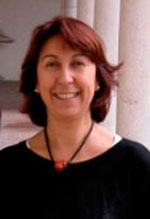 |
Silvia RAMBALDI (harpsichord) Sivia Rambaldi is a permanent teacher of harpsichord at the Bologna’s Conservatory, where she graduated unedr the guide of Annaberta Conti. She specialised with Jesper Bøje Christensen (Through Bass). She held masterclasses at the Ferrara’s University and in several Italian conservatories and private associations (Roma, Faenza, Montevarchi, Santu Lussurgiu, San Severino Lucano). She played as a soloist and in chamber groups. She collaborated with Orchestra Filarmonica Slovena, Ensemble Barocco of Bologna, Theatre of Smirne and Opera Theatre of Ankara (Turkey); with Musica Antigua of Palma De Mallorca; Theatre Rossini of Lugo, Festival Barocco of Viterbo and with |
| Bologna’s
Conservatory Orchestra and Carlo Mazzoli (duo of fortepiano). With
Bal’danza Ensemble played in Stockholm. She is playing with Bal’danza, Armonia delle sfere and Concerto segreto. She has an interesting proposal with Andreina Di Girolamo (harpsichord), Rita Marchesini (flamenco dancer) and Alberto Rodriguez (giutar) based on D. Scarlatti sonatas with through bass. With Tadashi Miroku she held concerts in Japan. She recorded for RAI and other television stations. For Tactus she recorded Variationi e partite by Bernardo Pasquini (Premio della Critica Discografica Tedesca 1999); Libro di fra Gioseffo da Ravenna (Premio della Critica Discografica Tedesca 2002); Madrigali diminuiti e passaggiati tra voce e cembalo and L’Armonia della Sirene, by G. B. Bassani with the counter-tenor Tadashi Miroku, Madrigali per Laura Peperara, Sei sonate per il clavicembalo by A. Ferradini, Ariette Op. VI by Barbara Strozzi. For the 250° anniversary of Mozart, she recorded, in duo with Andreina Di Girolamo, Sonate per clavicembalo a quattro mani by W. A. Mozart. For several years she has alternated the job as composer-concert artist with that one of researcher-musicologist. The fruits of his work are lectures and collaborations with musical revues: Quattrocentoquindici, Hortus Musicus, Arte organaria, and a new publishing of an ancient manupscript: Libro di fra Gioseffo da Ravenna. She collaborated with Daniele Salvatore, Santina Tomasello, Miho Kamiya and others, to bring the sound of ancient instruments of Tagliavini collection back to life, in particular during the cultural event “Bologna si rivela” (S. Colombano Museum of Bologna, from 2009). At the present time she’s studying plain chant. |
|
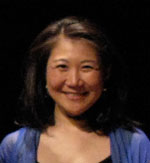 |
Miho KAMIYA (soprano) Miho Kamiya graduated as Liric Singer
in Tokio’s Arts and Music University with a research into music at
Ferrara at the court of Este Court. She studied medieval music at
Triburg (Holland) under the guide of Rebecca Stewart and baroque singing at the Verona’s Conservatory of music, under the guide of Cristina Miatello.
She won numerous prizes: the second prize at the Concorso Associazione della Musica Classica of Tokio; the special prize at the Debut Concert for Young Artists at the Tokyo Bunka |
| Kaikan. She
was finalist in the first edition of Concorso Internazionale della
Musica of Tokyo and 10th International Singing Contest New Voice of
Yokosuka (Japan). She cooperated with several Baroque orchesters and worked in several operas: L’incoronazione di Poppea by C. Monteverdi (Ottavia); Dido and Aeneas by H. Purcell (Belinda); Orphee aux Enfers by J. Offenbach (Minerva); The Old Maid and the Thief by G. C. Menotti (Laetitia). From 2007 she is working with Concerto segreto, an ensemble born in Ferrara under the guide of Elio Durante and Anna Martellotti, two musicologists, with a special attention for the famous “Concerto delle Dame di Ferrara”. She is collaborating, as singer and researcher, with the “Laboratori di Pratica Teatrale”, a project with the City of Ferrara, and the Conservatory of Music “G. Frescobaldi” and the “College of Architecture” of Ferrara. |
|
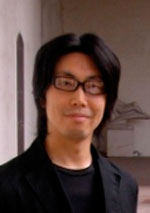 |
Tadashi MIROKU (counter-tenor) Tadashi Miroku graduated at the National University of Chiba (Japan). He graduated as Liric Singer in Tokio’s Arts and Music University. He studied baroque singing under the guide of Cristina Miatello, Santina Tomasello and Gloria Banditelli. In Italy he sang in many theatres: Bologna, Ferrara, Lugo, Verona, Urbino. He won several auditions and so he cooperate with several Italian musical groups: L’Homme arme, Accademia Bizantina, Bal’danza Ensemble, etc. He sang in several musical festivals: Monteverdi Festival of |
| Cremona, Viterbo Festival Barocco, Festival Musicale of Rovereto, Festival della Musica Sacra of Pisa, ecc. He recorded all CDs that Bach Collegium Japan dedicated to J. S. Bach and G. Fr. Händel (1996-1999). After studying in the University of Bologna (DAMS), he worked as theatrical director: of Operas (Dido and Aeneas by H.Purcell, La serva padrona by G. B. Pergolesi, La Dirindina by G. B.Martini, Il maestro di cappella by D.Cimarosa, Le nozze di Figaro by W. A. Mozart, Il Barbiere di Siviglia by G.Rossini, “Il segreto di Susanna” by E. Wolf Ferrari, etc.) and ancient music performances: Il festino della sera del giovedi grasso avanti cena and Barca di Venetia per Padova by A. Banchieri, “Kaffe-kantate” by J. S. Bach, etc. In Japan he sing with his groups Giardino Musicale and Trovatori Levanti. He held a workshop of “Baroque singing” at the Conservatory of Ferrara (2001-2003) For Tactus he recorded (in duo with Silvia Rambaldi): Madrigali diminuiti e passaggiati tra voce e cembalo, Cantate amorose and L’Armonia della Sirene by G. B. Bassani, Ariette Op. VI by Barbara Strozzi. Tadashi is a charter member of “Associazione Bal’danza” (Ferrara) and member of “Japan Federation of Musicians”. From 2006 he is a teacher of “Gakushin University. life-long Learning Center” (Tokyo). |
|
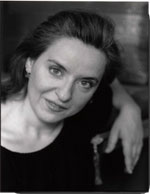 |
Santina TOMASELLO (soprano) Santina Tomasello graduated in Piano, Singing (Conservatory of Messina) and Harpsichord (Conservatory of Florence). Moreover she graduated in Arts (with a thesis on “Arie alla siciliana nel XVII secolo”) under the guide of prof. Piperno and, with prof. De Lisi, in Chamber vocal music (Conservatory of Florence). She studied Renaissance and Baroque repertory under the guide of Claudine Ansermet and Jill Feldmann, G. Garrido and A. Curtis. She began as singer in Dido and Aeneas (Second Woman) by |
| H. Purcell at the Niccolini Theatre of Florence. She singed in
prestigious centers: Queen Elisabeth Hall of London, Teatro La Pergola
of Firenze, The Greek Theatre of Taormina, and she worked with
performers such as Andrew Lawrence-King, Kees Boecke. Alan Curtis,
Gabriel Garrido, Giovanni Acciai, Howard Arman, Sergio Vartolo, Fabio
Lombardo etc. In the past years she singed as soloist in many productions: Johannes Passion, Matthäus Passion and Weihnachts Oratorium by Bach, various Stabat Mater by G. B. Pergolesi, A. Scarlatti and F. J. Haydn, Requiem by W. A. Mozart, Petite Messe solennelle by G. Rossini and then in Orfeo by C. Monteverdi, Aurora ingannata by G. Giacobbi, La purpura de la rosa by J. Torrejon, Rappresentazione di Anima e Corpo by E. De’ Cavalieri, La Liberazione di Ruggero dall’isola di Alcina, by F. Caccini, Erminia sul Giordano by M. Rossi, etc. She cooperated with several Baroque orchesters and worked with performers such as The Harp Consort, Complesso Barocco, I solisti del Madrigale, l’Homme Armé, I madrigalisti ambrosiani, Modo Antiquo, Athestis Chorus, Auser Musici, Musica Figurata. Santina partecipated to important musical Festivals: Festival of Ancient Music of Utrecht, Boston Early Music, Chaise-Dieu, Il Canto delle Pietre, Settembre Musica of Turin and Florence, Festival Cusiano di Musica Antica S. Giulio d’Orta, Settimana Intern. di Musica medievale e rinascimentale of Erice, Festival di Pieve e Castelli, Segni barocchi of Viterbo etc. With the lutist Gian Luca Lastraioli, Santina recorded two CDs with compositions by Cosimo Bottegari and Enrico Radesca, with a good success of reviews. She took part in tournées in Brasil, Germany, England, Israel, United States and Canada. She singed in contemporary works: Averroé By Marco Betta and Sogni Siciliani by Albino Taggeo. Santina has taught Baroque singing at the International Festival of Chamber Music of Paraiba (Brasil) and in the summer courses of Bagnacavallo (RA) and Castelluccio di Porretta Terme (BO), and at the Conservatory of Piacenza. At the present time he is a permanent teacher at the Conservatory “G.B. Martini” of Bologna. |
|
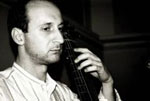 |
Perikli PITE (viola da gamba) Perikli Pite studied cello and composition in Albania (1991-1992, Arts Academy of Tirana, Prof. H. Hoxha and Arts High School Diploma – degree ). He won the first prize of the cello contest at the “Academy of Fine Arts” of Tirana. Then he pursued studying in Italy where he graduated in Cello – |
| degree with highest honours - (1999, Conservatory “G. Rossini” of Pesaro, Prof. Claudio
Casadei) and Viola da gamba – degree with highest honours - (2008,
Conservatory “Arrigo Boito” of Parma, Prof. Roberto Gini).He attended
master classes in Città di Castello (1996) and Saludecio (RN) (1998),
where he was awarded as best student. He attended some ancient music
courses: “Le Metamorfosi di Praga” in Venezia-S. Giorgio island
(2002), at the “Scuola Civica” of Milan (2001), Accademia “Franchino
Gaffurio”, Lodi (2001-2002), Città di Brunico: M° Stefano Veggetti,
Brunico -(2005). He won numerous scholarships and awards: Fondazione Gioacchino Rossini, Pesaro - 1997 and 1999, “800 festival di Saludecio” - 1998: prize best student, Cecilia Ugolini Paci, III edizione, Pesaro - 1999, Fondazione Giorgio Cini, Venezia - 2002, Liceo Musicale Pergolesi, Ancona Concorso “D. Caravita” of Fusignano: first prize as best ancient music ensemble, ensemble “Recitar Cantando” - 2004, TIM -Torneo Internazionale di musica: Honours Diploma - 1997 He cooperated with several orchestras (La Calandria, Europa Galante, Chamber Orchestra, Ancona, Marche Symphony Orchestra, Pesaro Symphony Orchestra, Marche Philharmonic Orchestra, Pro Arte Marche Orchestra, Arturo Toscanini Orchestra, Sassari Theatre Orchestra, Sanremo Symphony Orchestra, Italiana Philharmonic Orchestra, Piacenza, Luglio musicale Trapanese Orchestra, Albania Radio and TV Orchestra, Opera Theatre Orchestra, Tirana) and lyric institutions (Arena Sferisterio of Macerata, Festival Verdiano of Parma, Teatro Verdi of Sassari, Teatro delle Muse of Ancona) and worked with conductors such as Gustav Kuhn, Gianluigi Gelmetti, Angelo Carnpori, Nello Santi, Piero Bellugi, Massimo De Bernard, F. Biondi; and performers such as Luca Scandali, Alessandro Ciccolini,Gloria Banditelli, ensemble”Concerto” Roberto Gini, He cooperated with onde martenot soloist Jeanne Loriod and with theatrical director Michai Kosakowsky. He is member of “Rossini Cello Ensemble”. He played as soloist and in chamber ensembles in several festivals in Italy and abroad: Belfort Festival, France, University of Perugia, Festival of Saludecio, Lauro Rossi Theatre of Macerata, Auditorium Pedrotti and Rossini Theatre of Pesaro, Festival BWV Bach of Rimini, Orfeo by Monteverdi - 400° anniversary of first representation, Mantova, Teatro Bibbiena, 2007; Orfeo, by Monteverdi, Praga, Stavovskem Theatre, 2007 and National Theatre, 2008; Concert for the celebration of the 5th centennial of the Holy Sacrament Musical Chapel, following research on 1600’s manuscripts, 2007; Ensemble Europa Galante, in tour: Concertgebouw Amsterdam, Gulbenkian Grand Auditórium Lisbona, Barbican Centre London, Warsaw Philharmonic Concert Hall, Auditorio Nacional de Musica Madrid, Lucern, Budva Festival of Montenegro, Magie Barocche Festival of Catania, Pigna Festival Corsica etc. He recorded a CD with cello pieces by Gaetano Braga (Bongiovanni, Bologna 2001); one CD of unpublished pieces of the 1600s Roman school, and with ensemble Recitar Cantando and two-voice cantatas by Barbara Strozzi (Clavis 2010); with “Ensemble Concerto”, recording of Vespro della Beata Vergine by Monteverdi (Brillant 2010). |
|
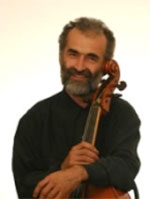 |
Mauro VALLI (Baroque chello) Mauro Valli was born in Sant'Agata Feltria, the same birthplace of Angelo Berardi. Valli descend from the great school of the legendary cellist Camillo Oblach, the favourite cellist of Toscanini famous for the magic velvet sound of his playing. After winning several competitions (Vittorio Veneto, Turin, Milan) he joined the Orchestra of "Teatro alla Scala" where he played under legendary conductors such as Leonard Bernstein, Carlos Kleiber, George Pretre. However his main interests have always been chamber music and baroque music and for this reason he left La Scala to devote himself |
| exclusively to playing and teaching in these areas. He has worked with notable musicians such as Maurice Steger (making with him very succesful recordings) and Anner Bylsma, who described him as a Master of embellishment. Member Founder of Accademia Bizantina, he has also played as soloist and first cello in others well known chamber music groups such as Quartetto Sandro Materassi, Il Complesso Barocco of Alan Curtis, I Barocchisti di Lugano of Diego Fasolis. He has appeared in some of the most important Concert Halls of the world, always to great acclaim. Both as soloist and as chamber musician, he has made many records with well known companies such as Decca, Denon, Harmonia Mundi, Arts, and these have always been favourably rewiewed; the records include Concerti by Vivaldi and Leo, Sonatas by Scarlatti and Trio Sonata by Bach, Corelli, Galuppi, Platti. His next CD - teh first worl recording of the Six Canzoni by Angelo Berardi - will be published by Sony. He also plans to record Bach Sonatas and Vivaldi Concertos with Diego Fasolis, with whom he regularly collaborates. His concerts have been transmitted by some of the main Radio and Television station of Europe. For about thirty years he has dedicated himself to playing baroque music on original instruments and to the rediscovery of historical instruments such as the five-stringed violoncello piccolo, the Arpeggione and the Baryton. He plays a cello made by Andrea Castagneri in 1740 and also uses a violoncello piccolo and a copy of a Montagnana made by the violin makers Lucia Valli and Matias Herrera. With theyr help he has produced a copy of an Arpeggione conserved by the Museum of Musica Instruments of Berlin. He has a lecturer in chamber music at the Conservatorio of Bologna, and he has taught for ten years at the Conservatorio della Svizzera Italiana of Lugano. |
|
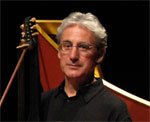 |
Stefano ROCCO (theorbo and baroque guitar) Stefano Rocco
studied renaissance lute at the Conservatory of Verona and he graduated
at the University of Bologna (DAMS).
He played in the most important international festivals: (Utrecht, Salzburg-Festspiele, Roma-S.Cecilia, “la Caixa” Barcellona, Resonanzen Vienna-Konzerthaus, |
| Madrid-Auditorio Nacional, Tokyo Summer Festival, Europäische Wochen
Passau, Innsbruck, S.Maurizio-Milano, Schleswig Holstein, Festival
delle Fiandre, Kyburgiade-Winterthur, Sablé sur Sarthe, Palermo-Antonio
il Verso, BolognaFestival, Parigi-Abeille Musique, Napoli-Pietà dei
Turchini, Melk, Amadeus-Genève, Sierre-Espace2,
Musikfestspiele-Potsdam, Pigna, Regensburg, Monteverdi-Cremona, Israel
Festival, Torino-Settembre Musica, Donau Festival, Trento-Musica
Antica, Trigonale. La Folia-Rougemont, NewYork-Mostly Mozart-Lincoln
Center, Valencia-Palau de la Musica, Trigonale, Bruxelles-Klara
Festival, Sagra Musicale Umbra). He cooperated with several Baroque orchestras and worked with performers such as Marco Beasley and Guido Morini (ensemble Accordone), I Barocchisti of Lugano, two lutes formation Calliope, Orchestra Barocca of Bologna, ensemble Respighi, Cantilena Antiqua, Concertino Amarilli etc. He recorded for the Radio della Svizzera Italiana, Alpha, ORF (Radio Österreich), OPUS 111, Radio Belga, ESPACE 2 (Suisse Romande), RAI, Cypres, Tactus, Bongiovanni. He has taught at the Musical Centre of Trieste’s University and in the summer courses of Perinaldo. Top |
|
| The Bank of Turf |
| Irish and Scottish Folk Music Emanuela Di Cretico: Tin Whistles, Percussions Annamaria Arcangeli: Voice, Percussions Roberto Galvani: Violin, Mandolin Daniele Salvatore: Flute, Guitar, Bodhran Dante Bernardi: Scottish Pipe, Spoons Info: Emanuel Di Cretico Top |

